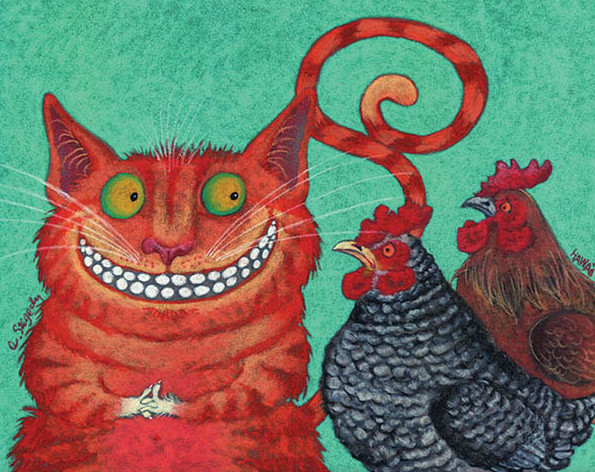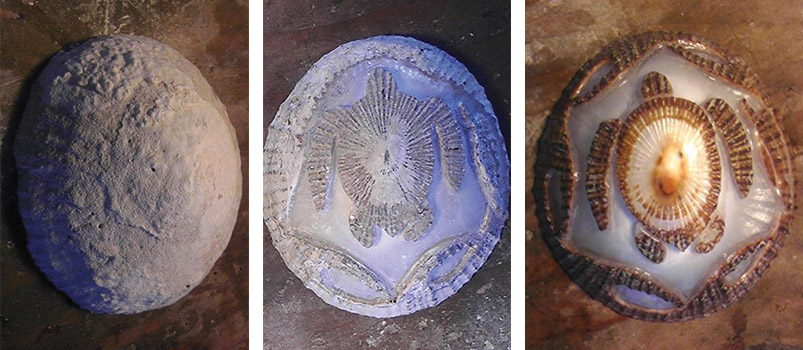
Deadly Charms: Creating Beautiful Jewelry from Hawai‘i’s “Fish of Death”
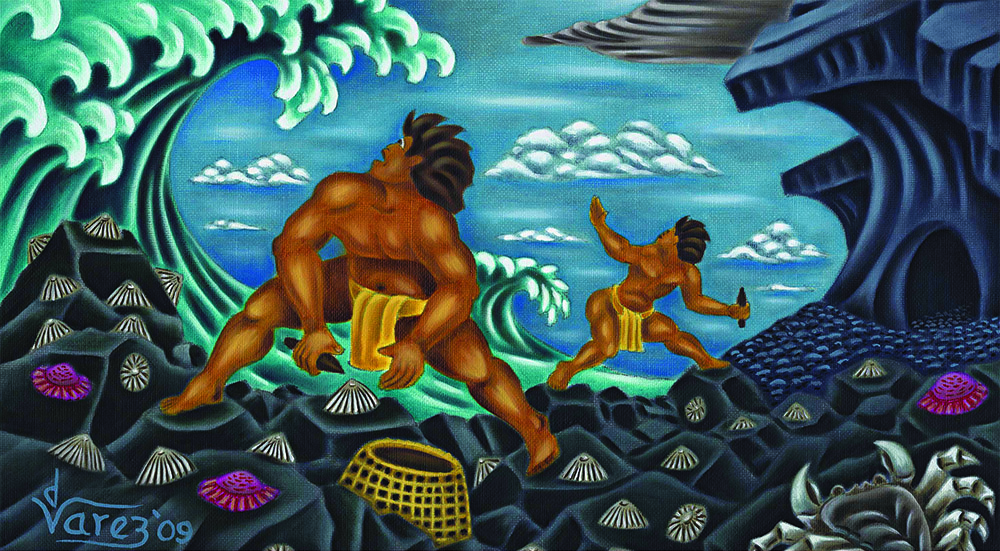
By Denise Laitinen
Can you name the “fish of death” in Hawai‘i? Think it’s ciguatera, the foodborne illness found in many parrot and trigger fish? You’d be wrong. Think it’s the feared tiger shark? Guess again.
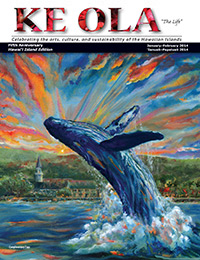
Hawai‘i’s “fish of death,” (he i‘a make) is not a fish at all, rather, a tiny limpet with a cone-shaped shell only a few inches in diameter. ‘Opihi are often found along Hawai‘i’s rocky shorelines where they eat algae.
The unassuming mollusk got its nickname because it is incredibly dangerous to collect ‘opihi along Hawai‘i’s rocky coastline amidst pounding surf. Since December 2012, three people have died on Hawai‘i Island alone while picking ‘opihi with an additional 13 people killed on-island between 1999 and 2009.
People risk their lives to collect the small limpets because they are prized for their tangy taste. Eaten raw or grilled, ‘opihi have been a staple at Hawaiian family lū‘au and parties for generations.
The popular sea creatures vary in size and color depending on where they live in the coastal zone. Yellowfoot ‘opihi, or ‘opihi ‘ālinalina, have a yellow tint to the shells and prefer the constant surf of the low tide zone. Blackfoot ‘opihi, or ‘opihi makaiauli, are among the most harvested because they prefer calm waters.
The most coveted ‘opihi, the ‘opihi kō‘ele, are the biggest—and can be up to four inches in diameter. However, the yellow and gray colored ‘opihi kō‘ele are also the hardest to find and require diving to depths of 10 feet.
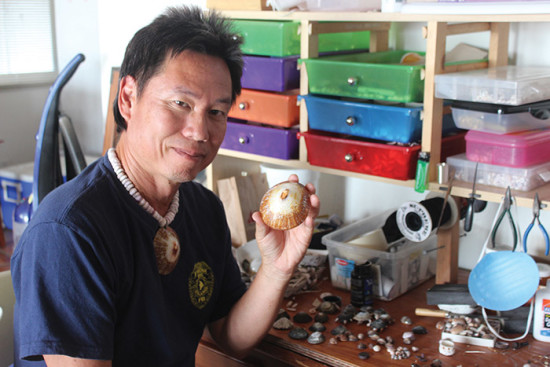
Rough with sharp edges and dull in color, ancient Hawaiians used the ‘opihi shells for fertilizer, to scrape taro and breadfruit, and as jewelry.
Today, at least two Hawai‘i Island craftsmen, Wil (Kauoha) Costa in East Hawai‘i and Billy Lum in West Hawai‘i, are continuing the old practice of creating exquisite jewelry from ‘opihi shells. Both are also concerned about the future of the Hawaiian delicacy, which is now threatened due to constant demand and overharvesting.
Billy Lum has collected ‘opihi shells for decades and turns those shells into necklaces, earrings, and bracelets. The Kailua-Kona resident says these days he has to go “farther and farther to find ‘opihi shells.” He combs the beaches of the Kohala and Kona coasts, traveling south to Ka‘ū and north to Hawi.
Billy says that all too often when he comes across ‘opihi shells left behind at a campsite on the beach, the shells are small.

“Sadly, a lot of the ‘opihi shells I find now are small, meaning people are picking the illegal ones.” (State regulations require an ‘opihi shell to be at least 1.25 inches in diameter before it is harvested.) Billy is reluctant to pick up the small shells, because he doesn’t want people to think he was responsible for picking ‘opihi illegally.
Wil (Kauoha) Costa of Pāpa‘ikou, echoes Billy’s sentiments. The ‘opihi jewelry artisan says he has stopped gathering ‘opihi entirely, and relies on his massive collection of shells gathered over a lifetime of fishing and diving.
The two men, both skilled artists, share many similarities and do not know each other. Yet their love and respect for the ocean led each man to pursue their passion of creating jewelry from ‘opihi shells.
Billy grew up on O‘ahu in Kalihi Valley where he learned how to read tides and waves as a surfer. As a youngster, his Boy Scout scoutmaster would take the boys to the ocean and teach them what was edible and how to live off the land.

After graduating from Honolulu Community College with a degree in auto body repair, Billy moved to Maui and then Hawai‘i Island in 1987. Over the years, he changed professions, working as both a real estate agent and bartender, while his love of the ocean remained steady. When his son, Ikaika, and daughter, Kiana, were young, Billy spent more time in tide pools than surfing. Thus, his shell collection increased.
Like many, when Billy ate ‘opihi with family and friends, he would throw the shells in a bucket.
“Over the years, my shell collection became quite large,” says Billy.
In 2010, he saw a woman wearing a polished abalone shell necklace and had an epiphany on what to do with his shell collection. “I realized I could do the same thing with ‘opihi shells,” he says.
“I got a large shell and started grinding it down with my sander. It took a while, but the more I sanded, the more beautiful it got!
“I transformed what looked like a barnacle into an amazing work of art. That was it—I was hooked!”
Billy pursued his hobby while working as a bartender at the Hilton Grand Vacations Club, where he still works today.
He uses a variety of tools to sand the shells then hand polishes them to bring out their luster. He uses only all-natural materials, stringing the shells with hemp or cotton rope. Each piece of jewelry takes a couple hours to create.
Billy started making ‘opihi necklaces for family and friends. Soon, tourists at the bar began asking to purchase his jewelry. That led to being asked to showcase his work in a local art gallery. Today, Billy’s ‘opihi jewelry is available at Wishard Gallery in Waikoloa and Waimea.
Like Billy, Wil (Kauoha) Costa grew up on O‘ahu and also has a deep appreciation of the ocean. He also did not start out his career as a jewelry artist.
Wil grew up on O‘ahu’s north shore where the beach and ocean were his playgrounds. An avid fisherman, he would pick and eat ‘opihi while fishing.
“I was raised on the beach, so ‘opihi shells were a by-product of our fishing excursions,” says Wil.
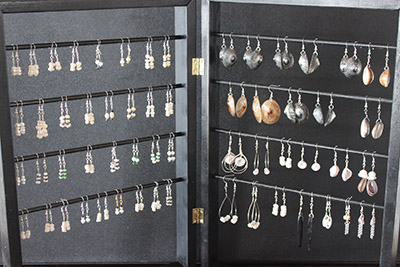
After high school, Wil joined the Navy where he worked in naval construction for four years. Returning to Hawai‘i after his military service was completed, a chance encounter led him to move to Hawai‘i Island. While visiting Hilo to help a relative move in 1989, Costa was offered a construction job and decided to make the move.
While working full time in construction, Wil would spend his weekends camping and diving—pastimes that both continued after he met and married his wife, Russlyn Alohilani Mercado.
“We’d load up the truck and go on diving adventures on the weekends. We would go camping at places like ‘‘opihi hale’ [in Hilo], Puna, and Punalu‘u. We’d collect ‘opihi for our family gatherings and lū‘au and then I’d save the shells afterwards,” recalls Wil.
While Wil was diving, Russlyn would sunbath on the shore where she would sand ‘opihi shells.
“I’d have to find just the right type of lava rock,” explains Russlyn. “I’d rub the shell against the rock and sand it down. Then when it got to a certain point, I’d find a different grain of lava rock and sand it further.”
Wil began sanding shells using sanders and grinders, and the Costa’s shell collection grew as Wil perfected his technique.
Working with ‘opihi shells continued as a hobby for Wil until one fateful day in 2006 when a drunk driver plowed into Wil’s car while he was stopped at a stoplight. His injuries were severe enough that he was unable to continue working construction and needed to find a new career. As he recovered from his injuries, Wil decided to turn his passion for creating ‘opihi jewelry into a full time profession.
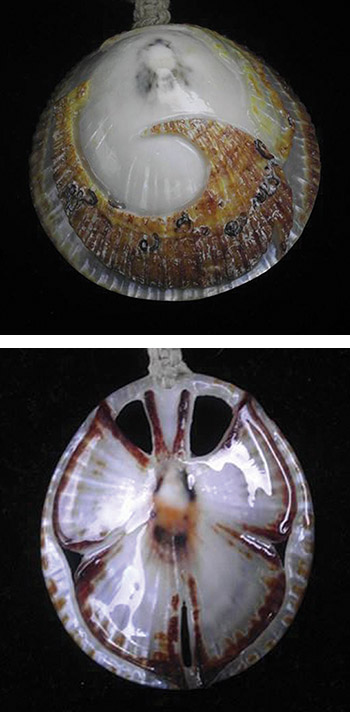
Wil is unique among ‘opihi shell jewelry artists in that he not only sands the shell—he carves into it, creating exceptionally detailed three-dimensional artwork on the shell itself.
Some of his most popular designs include a fishhook, honu (Hawaiian sea turtle), dolphin, and taro plant. He even creates small triangle diamonds along the side of a shell to represent tapa designs.
He first sketches a design on the shell. After carving out the design with small hand tools, grinders and sanders, Wil then polishes the remainder of the shell to a white opalescent shine. The pearlized color of the shell contrasts nicely with the amber and grey tones of the top layer of the carved shell. After polishing the piece, Costa seals it with a resin glaze as a finishing step to protect the ‘opihi shells from wear and tear. It’s a time consuming process with each piece requiring 8-12 hours of work.
Like Billy, Wil uses only all-natural materials for the necklaces for the ‘opihi shells.
“Having worked on construction so long, I’m used to making things that are strong,” says Wil. He double and triple braids hemp ropes that are “built for a lifetime of use.”
While Wil is responsible for carving the ‘opihi, Russlyn braids the cords for the necklaces and assembles the jewelry.
The Costas offer a lifetime guaranty on the knots used in the necklaces and also provide a certificate of authenticity with each piece of jewelry.
You can find their ‘opihi jewelry at Burgado Galleries, Hawaiian Force in Hilo, Keaukaha Market, and Got Gifts in Prince Kuhio Plaza. ❖
Contact Billy Lum: OpihiMann.com
Contact Alohilani’s Opihi Art & Jewelry: Alohilaniarts@gmail.com, facebook.com/Alohilanisart
Contact writer Denise Laitinen: wahineokekai@yahoo.com
